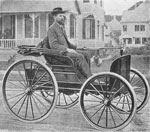
The great horseless carriage race of 1895 set the stage for the introduction of the motor car in the US. Organised by the Times-Herald newspaper of Chicago, it was hailed as the defining race to prove the viability of mechanical transport.
But as The Engineer reported, the competition got off to a shaky start. It was due to run on 2 November, however, only two entries were ready to compete and a decision was taken to postpone the race until later that month.
The gasoline tanks carry a supply sufficient for a 150-mile run
Entrants H Mueller and CE Duryea were nevertheless determined to run on the original date and arrangements were made for the two cars to race head to head on the 92-mile road track from Chicago city to Waukegan and back.
The H Mueller entry was a four-wheel open carriage. It ran on a 3hp Benz gas engine, consuming around one pint of gasoline per hour. The rear wheels were driven from the motor shaft by a chain-and-sprocket wheel on the carriage axel.
The Duryea motor carriage is a four-wheel buggy, seating two persons, and has ball bearings for the axles and rubber tires on the wheel,’ according to The Engineer. ’The gasoline tanks carry a supply sufficient for [a 150-mile] run and can be recharged in five minutes.’
H Mueller made the run in nine hours 20 minutes averaging a speed of 10mph, with a maximum speed of 12mph. The Duryea motor carriage, however, encountered some problems and was finally run off the road by an approaching wagon.




Red Bull makes hydrogen fuel cell play with AVL
Formula 1 is an anachronistic anomaly where its only cutting edge is in engine development. The rules prohibit any real innovation and there would be...